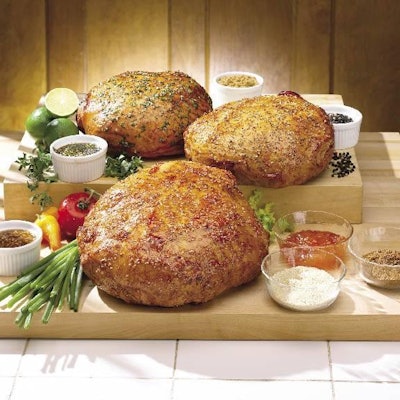
January, 2006- The U.S. turkey industry enjoyed an exceptional year of profitability in 2005. Industry losses caused by oversupply led to cutbacks in poult placements and some plant closings at the end of 2004, which set the stage for real volume reductions in 2005. The bumper grain harvests in 2004 and 2005 gave the industry relatively low feed prices last year. Low production costs and a tight turkey supply combined to give many turkey processors record returns. High breast meat and dark meat prices rarely occur at the same time, and in 2005 the turkey industry had both.
Turkey processors report in WATT PoultryUSA’s Top Turkey Company Survey that total industry live pounds processed in 2005 were expected to be around two and a quarter percent less than in 2004. USDA slaughter data through the end of October 2005 show that USDA inspected plants processed 3 percent less head versus the same period in 2004. But, live weight processed through October was 1 percent higher in 2005 than in 2004, because the average bird weight increased from 27.2 pounds in 2004 to 28.2 pounds in 2005. Whether the total slaughter volume for 2005 ends the year down slightly from 2004, or up slightly, supply was tight enough during the year to drive prices up to levels that the industry had not seen in years. Also, at the end of October, the USDA reports that total turkey in commercial freezers was down 10 percent from October 2004, but what does all this mean for 2006?
The only thing that cures low prices is low prices, and unfortunately, the converse is also true. Turkey processors report in WATT PoultryUSA’s Top Turkey Company Survey that they expect to process 4.7 percent more tonnage in 2006 than they did in 2005. In November, the USDA reported that cumulative poult placements for the 2006 marketing year were up 5 percent over the same period a year earlier. An increase of this magnitude in poult placements coupled with the usual increase in average bird weights could result in a total volume increase of more than the 4.7 percent projected in this survey.
There are other factors driving the expected increase in supply in 2006, besides the high returns experienced by the industry in 2005. Dakota Provisions is expected to open its new slaughter, deboning, cooking and slicing plant in Huron, S.D., in early January of this year, and the company expects to process 150 million live pounds of toms in 2006. Dakota Turkey Growers is a cooperative that owns Dakota Provisions, and the cooperative’s members have been raising turkeys for other processors for years. Basically, all of the processors who have been receiving birds from Dakota Turkey Growers’ farms report that they will replace the volume lost to Dakota Provisions from other sources. So, it appears that most of the 150 million pound volume of Dakota Provisions will represent new volume to the industry. Dakota Provisions will be the first “new” slaughter plant in the industry since 1989, because other plants that have opened since then were replacements or were old plants which were remodeled and re-opened.
Prestage Foods is adding a second shift to its St. Pauls, N.C., slaughter plant in January of 2006, and the company will increase its volume slaughtered by 120 million live pounds this year. This new shift will process toms that Prestage Farms had been raising for slaughter by Cargill at the company’s Dayton, Va., plant. Cargill has reported that it is replacing the Prestage volume and it will increase its total volume by 14 million live pounds in 2006. Industry sources report that Circle S Farms Monroe, N.C., is raising toms for Cargill to replace the Prestage Farms birds. The combined impact of the opening of Dakota Provisions and the addition of the second shift at Prestage Farms coupled with the replacement of these birds by other processors could account for as much as a 4 percent increase in total turkey industry slaughter volume in 2006.
Jennie-O Turkey Store increased its volume slightly in 2005 and remains in the top position in the survey with 1.265 billion live pounds processed, and the company plans to maintain its slaughter at this level in 2006. Cargill Value Added Meats slaughter volume dropped by 19 million pounds to 947 million live pounds, but the company remains in the second spot in the rankings. ConAgra’s Butterball Turkey plants processed an estimated 840 million live pounds in 2005 and the food industry giant is the third largest processor of turkeys in the USA. Carolina Turkeys’ slaughter volume dropped by 125 million pounds to 600 million pounds in 2005 with the closing of Circle S Foods’ Wallace, N.C., processing plant, but Carolina still claims the fourth spot in the survey.
Sara Lee’s Bil Mar Foods division is estimated to be the fifth largest turkey company with 280 million live pounds processed in 2005. Industry sources report that Bil Mar plans to replace live volume lost to Dakota Provisions in 2006 from other sources. Perdue moves up to the sixth spot in the rankings in 2005 with 245 million live pounds processed at the company’s Washington, Ind., plant. House of Raeford climbed to seventh in the rankings from ninth in 2004 by processing 241.5 million live pounds in 2005, and Foster Farms remains in the eighth position in the survey with 229.5 million live pounds processed in 2005. Kraft Foods turkey processing plant in Sumter, S.C., is estimated to have processed 205 million live pounds in 2005 and is ninth in the rankings.
Pilgrim’s Pride falls from fifth in the rankings in 2004 down to fifteenth in 2005 largely due to the sale of its Hinton, Va., plant to Virginia Poultry Growers Cooperative (VPGC). VPGC is now the tenth largest turkey company with 200 million live pounds processed in 2005. The top ten turkey companies processed an estimated 76 percent of the industry’s total volume in 2005, down from nearly 81 percent reported in last year’s survey.
Dakota Provisions will not be the only new turkey plant that opens in 2006. Michigan Turkey Producers is planning to open a new cooked products plant in Wyoming, Mich., early in 2006, just a few miles from its slaughter and deboning plant. Initially the plant will be configured and equipped to produce 20 million pounds of cooked product annually, but there is enough processing space in the 100,000-square-foot facility for the capacity to be increased to 50 million pounds per year in the future.
The turkey industry had one of its best years ever in 2005. The double-edged sword of high grain prices and low meat prices that struck the industry in 2003 and 2004 was completely reversed last year. Logically, high prices and low costs and the resulting high profits will lead to increased production, and the turkey industry is planning on increasing output in 2006. How long will prices hold if meat production increases to the extent predicted by this survey? Will consumption both domestically and overseas increase enough to keep prices profitable in 2006? The only certainty is that 2006 should be an interesting year.


















